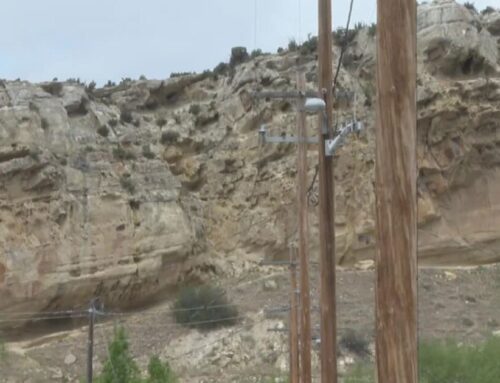A 20 Percent Electric Bill Surge Tests New Jersey’s Climate Goals
May 17, 2025
On June 1, New Jersey residents will face something they’ve dreaded for months: A nearly 20 percent rate increase in their electricity bills.
A leading state in climate policy, New Jersey is being squeezed by soaring energy demand from data centers and a sluggish connection of renewable sources by grid operator PJM Interconnection.
“That’s a historic spike,” Abraham Silverman, an energy researcher with the Ralph O’Connor Sustainable Energy Institute at Johns Hopkins University, said about the rate hike. State leaders have spent the past few months in fiery legislative hearings, filing a flurry of bills to try to cushion the financial blow to consumers and demanding an investigation of PJM by the federal government.
PJM is the largest electric grid operator in North America, servicing 65 million customers across 13 states and the District of Columbia. This month, PJM forecast that summer could be a challenge even with the rate hike. It expects to have enough electricity to meet typical peak demand, according to a company release, but warm weather energy demands could push the grid to its limit.
Get Inside Clean Energy
Today’s Climate
Twice-a-week
A digest of the most pressing climate-related news, released every Tuesday and Friday.
Get Today’s Climate
Breaking News
Daily
Don’t miss a beat. Get a daily email of our original, groundbreaking stories written by our national network of award-winning reporters.
Get Breaking News
PJM also said it has approved 2,275 megawatts of battery storage projects amid a push to shore up grid reliability. Set to operate by 2030, the projects span several states and are being prioritized for faster grid connection. In April, PJM announced a partnership with Google and its subsidiary Tapestry to configure artificial intelligence into its grid connection and data verification process.
It remains to be seen whether AI will help or simply add another layer of complexity to an already overburdened grid system.
Criticism over the energy dilemma in New Jersey has largely fallen along party lines.
Republicans have blamed the ambitious climate policies set by Gov. Phil Murphy, who aims for all electricity sold in New Jersey to come from clean carbon-free sources by 2035. In April, a Republican caucus pushed back on the state’s clean energy plans with a pointed letter to the New Jersey Board of Public Utilities.
“The current administration’s advocacy for 100 percent clean energy by 2035 is infeasible and, frankly, unachievable. In 2023, nearly half of the electricity generated in-State came from natural gas-fired power plants. Replacing that much electricity with renewable resources such as solar and wind is unrealistic,” the Senate Republican Caucus wrote.
Democrats have blamed PJM, in large part, for poor planning and rising bills—a charge leveled by a number of other states. New Jersey’s ambition for clean energy is not the problem, they say, and members who participated in a joint legislative hearing in late March were blunt about PJM’s role.
“As we work to understand why energy costs have spiked, today’s hearing makes one thing clear: among the leading causes are PJM’s broken capacity auction system and its failure to bring new energy supplies online. Rather than taking responsibility, PJM continues to deflect blame,” a committee statement said.
How Did New Jersey End up Here?
Electricity costs in New Jersey are rising because of heightened “capacity costs,” the charge for ensuring power plants can meet demand anytime. Plans for data centers, which need round-the-clock energy, are a major driver of new demand.
Silverman offered an analogy: Think of an electric bill like owning a car. Gas isn’t the only expense. It includes the lease for parking, on standby for your use. And the lease payment suddenly became much more expensive.
The price for capacity in PJM’s annual auction—where local power providers bid to be on call to meet future demand—skyrocketed nearly tenfold in some regions, going from $34 to $270 per megawatt-day in just a year. Capacity makes up roughly a fifth of a typical energy bill.

PJM’s 2025 long-term forecast estimates summer peak demand over the next decade will increase more than 3 percent annually—far faster than prior estimates. Winter demand will also increase, close to 4 percent annually. A separate analysis by consulting firm Synapse Energy projects that data centers, still in the planning stage, could consume nearly a quarter of PJM’s total electricity by 2040.
Both PJM and Synapse Energy cited data centers, both new and expanding, as accelerating demand. There are over 3,700 data centers in the country, according to tracking site Data Center Map. Tech giants including Amazon, Google and Microsoft are expanding operations across PJM’s service region, with Virginia and Ohio leading the boom.
A December 2024 report by a Virginia legislative commission found that Northern Virginia, with 512 centers then, accounted for 13 percent of all data center capacity worldwide. That is a quarter of capacity in the Americas. As of this month, there are 576 centers there, Data Map shows.
Ohio is experiencing its own surge, with at least 181 data centers in the state, including 114 in the Columbus area, ranking the state fourth in the U.S. for development. These facilities support cloud computing, artificial intelligence and data storage.
Utilities have often passed on the higher costs of the companies’ energy demand to all their ratepayers. A Harvard Law School study from March found that utilities routinely enter into confidential agreements with data center operators, offering them discounted electricity rates while shifting the financial burden of grid enhancements to the public. Researchers reviewed nearly 50 regulatory proceedings about utility rates for data centers.
The study found that “by 2030, data centers may consume as much as 12 percent of all U.S. electricity and could be largely responsible for quintupling the annual growth in electricity demand.”
Some stark costs are apparent now. In Virginia, Dominion Energy has proposed a 15 percent rate increase, citing surging demand from data centers and rising infrastructure costs. In Ohio, the Northeast Ohio Public Energy Council warned residents that the average household in the state could see monthly electric bills rise by 10 to 15 percent starting in June.
Daniel Lockwood, a PJM spokesperson, said New Jersey is an example of rising costs but “these current supply and demand dynamics are not just happening in New Jersey. They are occurring across the PJM footprint, in the rest of the country and around the world.
“The issue in New Jersey is particularly acute,” he said, “because the state imports approximately 35 percent of its power annually.”
New Jersey hosts fewer data centers, but the overall demand across all states in its grid are affecting its pricing, according to PJM. The other states are Delaware, Illinois, Indiana, Kentucky, Maryland, Michigan, New Jersey, North Carolina, Ohio, Pennsylvania, Tennessee, Virginia and West Virginia.
Electricity demands are spiking as older power plants are retiring, and new clean energy projects are waiting for years in PJM’s backlog for evaluation.
PJM and Renewable Troubles
Before a clean energy project can connect to the grid, it is evaluated by PJM through a series of technical studies that determine whether the project will strain the system and what grid upgrades are needed. Developers seek PJM’s interconnection service agreements as they apply for permits to build and site approval from various government agencies.
Interconnection wait times have increased from two years in 2007 to more than four years in 2023, according to a 2024 report from Lawrence Berkeley National Laboratory, largely because of the studies.
In 2023, the Federal Energy Regulatory Commission mandated a nationwide overhaul of the interconnection process, ordering providers to complete studies within 150 days. PJM requested an exemption, triggering public criticism.
Lockwood, the PJM spokesperson, said the company has reformed its interconnection process by moving from a system that reviewed projects as they were filed to prioritizing the most prepared applications. That change has helped spur approvals and cut delays. “Under the new cycle process, study time is expected to be 1-2 years,” he said in an email.
PJM aims to resolve a backlog of applications by the end of 2026, Lockwood said.
New Jersey’s last two coal-fired power plants ceased operations in 2022, and the Oyster Creek Nuclear Generating Station, once the nation’s oldest operating nuclear plant, was retired in 2018.
Then came some unexpected commercial trouble for a planned renewable source.
Ørsted, the Danish energy giant and a global leader in offshore wind, had won a contract from New Jersey for a wind farm project—Ocean Wind 1 in 2019 and Ocean Wind 2 in 2021—that was to generate over 2,200 megawatts. The initial phase, estimated to cost close to $700 million, was planned to come online in 2025 with the second phase in 2029. The project was meant to provide a third of the state’s 2035 offshore wind target.

But in late 2023, Ørsted abruptly canceled, citing rising costs, interest rates and supply chain delays. The decision stunned officials and left a major gap in New Jersey’s clean energy plans. Ørsted was obligated to pay up to $300 million in guarantees but ultimately settled with the state to pay $125 million.
The delays getting other renewables on the grid just added to the state’s troubles.
“We literally blew up a coal plant three years ago that was retiring and not competitive in the market, and a solar storage facility was supposed to replace it. That project still isn’t online. This gets to the issue of PJM,” said Doug O’Malley, director of Environment New Jersey, an advocacy group.
New Jersey’s Climate Goals
The 2020 Energy Master Plan for New Jersey envisions a transformation of the power sector that sets a target of 100 percent clean energy by 2050. Two years ago, Murphy accelerated the goal to 2035 for all electricity sold in the state.
New Jersey has more than doubled its in-state solar generation since 2017 and has pursued one of the most ambitious offshore wind programs in the country—despite the Ørsted cancellations. In 2022, the New Jersey Board of Public Utilities (NJBPU) approved a coordinated offshore wind transmission planning rule, laying the groundwork for integrating large-scale wind into its grid. New Jersey still aims to reach 7.5 gigawatts of offshore wind by 2035.
NJBPU President Christine Guhl-Sadovy recently testified to the New Jersey Senate that 79 clean energy projects remain stalled, but the problems were not a reason to stop renewable energy efforts. Based on NJBPU’s count, these delayed projects add up to over 4 gigawatts of delayed capacity. “Clean energy can and has driven down capacity prices,” Guhl-Sadovy said.
Without renewables in the mix, New Jersey residents would pay an additional $1 billion for electricity in 2025, she said.
O’Malley of Environment New Jersey said accountability was important in understanding the delays. “The queue doesn’t lie,” O’Malley said. “Instead of having new power plants ready to take advantage of rising prices, we hit a wall because PJM’s interconnection process failed to get them online in time.”
During a legislative hearing in March 2025, Brian Lipman, director of the New Jersey Division of Rate Counsel, testified that PJM’s failure to bring new energy supply online has led to higher utility costs for residents.
“We must demand that PJM do better,” said Lipman. “Business as usual is not going to work. The time where PJM can place costs and the issue of affordability on the back burner has passed.”
This story is funded by readers like you.
Our nonprofit newsroom provides award-winning climate coverage free of charge and advertising. We rely on donations from readers like you to keep going. Please donate now to support our work.
Experts say that New Jersey’s clean energy policies may actually be key to solving it. PJM itself has said as much.
“By no means are renewables to blame,” PJM’s Lockwood said. “We need all the supply we can get to assist with this supply-demand challenge and that includes renewables. However, policymakers should be aware that not all resource types are the same. It will take a significant amount of, for instance, solar to replace one retiring gas generator.”
A recent state consultant report warned that hitting New Jersey’s 2035 climate targets will require a “steep ramp-up” in deploying electric vehicles, heat pumps and grid-scale renewables.
Energy Storage Plans
One of the most promising strategies is energy storage, which experts say can bridge the reliability gap between intermittent renewable generation and real-time demand.
NJBPU is preparing to launch an energy storage program to help integrate more solar and wind into the grid. Paired with clean energy, storage could provide peak-hour power that currently depends on gas and oil.
New Jersey is also reconsidering nuclear power. In April, NJBPU issued a request for information to explore if advanced nuclear technologies could fit the state’s energy landscape. The board wants utilities, developers and researchers to help assess whether nuclear, particularly smaller next-generation reactors, could provide zero-emissions power and bolster grid reliability.
Robert Mieth, assistant professor specializing in electricity markets at Rutgers University, said more investment in renewables is needed even if it means high upfront construction costs that will be charged to consumers over time.
“We have to pay for new transmission lines. We have to pay for new generation. But down the road, we’ll see a return on this investment,” Mieth said. There will be a more reliable grid, lower rates and stronger energy economy overall, he said.
Mieth also highlighted the need for public understanding and coordination across states—and the promise of the newly formed Northeast States Collaborative on Interregional Transmission. Nine states are cooperating to create a framework for identifying, advancing and financing projects that serve public-interest goals, not just market profits.
“Any form of interstate cooperation, meaning an understanding that local investments in a specific state may also have a benefit in other states in this interconnected area … will lead to efficiency gains overall in the system,” he said.
About This Story
Perhaps you noticed: This story, like all the news we publish, is free to read. That’s because Inside Climate News is a 501c3 nonprofit organization. We do not charge a subscription fee, lock our news behind a paywall, or clutter our website with ads. We make our news on climate and the environment freely available to you and anyone who wants it.
That’s not all. We also share our news for free with scores of other media organizations around the country. Many of them can’t afford to do environmental journalism of their own. We’ve built bureaus from coast to coast to report local stories, collaborate with local newsrooms and co-publish articles so that this vital work is shared as widely as possible.
Two of us launched ICN in 2007. Six years later we earned a Pulitzer Prize for National Reporting, and now we run the oldest and largest dedicated climate newsroom in the nation. We tell the story in all its complexity. We hold polluters accountable. We expose environmental injustice. We debunk misinformation. We scrutinize solutions and inspire action.
Donations from readers like you fund every aspect of what we do. If you don’t already, will you support our ongoing work, our reporting on the biggest crisis facing our planet, and help us reach even more readers in more places?
Please take a moment to make a tax-deductible donation. Every one of them makes a difference.
Thank you,
Search
RECENT PRESS RELEASES
Related Post





